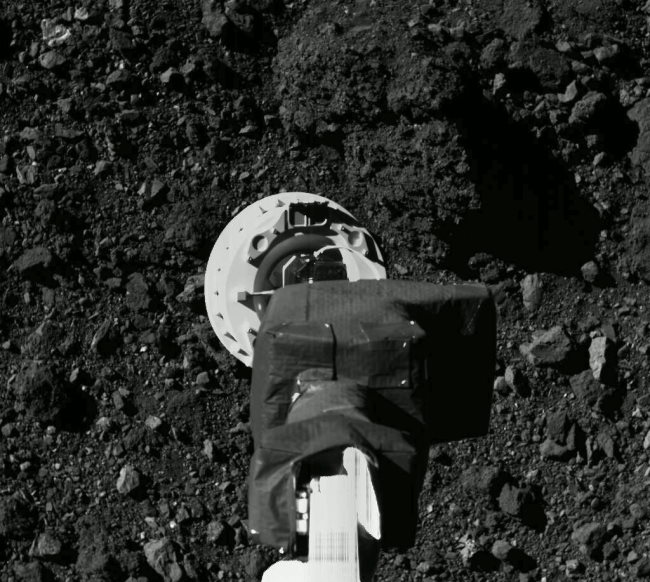ALMA, SpaceX, BepiColombo flies by Venus, OSIRIS-REx lands on an asteroid and NASA partners with Intuitive Machines
ALMA maps effects of volcanos on IO’s atmosphere.
Jupiter’s moon Io is the most volcanically active object in our solar system, hosting over four hundred active volcanos that constantly bathe the surface of the planet in sulfur gasses, which give the moon its characteristic color pallet when they freeze.
It is currently unknown what exactly happens inside the moon to cause all this volcanic activity, but scientists hope that studying its atmosphere could shed light on that. They have used Atacama Large Millimeter/submillimeter Array (ALMA) to map the concentrations of sulfur and observed the moon under different conditions.
 Image Credit: ALMA (ESO/NAOJ/NRAO), I. de Pater et al.; NRAO/AUI NSF, S. Dagnello; NASA/JPL/Space Science Institute
Image Credit: ALMA (ESO/NAOJ/NRAO), I. de Pater et al.; NRAO/AUI NSF, S. Dagnello; NASA/JPL/Space Science Institute
In direct sunlight there is enough heat for the gas to remain, but when the moon moves into Jupiter’s shadow, temperatures on its surface drop rapidly to the point where even the atmosphere starts to liquify. This means that if scientists observe IO during such an eclipse, that any hot sulfur in the atmosphere has to be spewed up by the volcanos recently.
By observing the moon during several such eclipses, they found that 30 - 50 % of Io’s atmosphere is directly produced by the volcanos.
Video showing volcanic impact on Io’s atmosphere: https://vimeo.com/468104117
SpaceX’s ‘Starman’ makes closest approach to Mars
SpaceX was the first ever company to successfully launch a car into space, achieving this feat on the 6th of February 2018 with their Tesla Roadster that was ‘piloted’ by a SpaceX spacesuit. Originally the car was meant to go to Mars and to be ‘parked’ in orbit around the planet. Unfortunately, the rocket overshot and the car missed the Planet, now flying into deep space. This month, more than 2 years later the roadster made its closest approach to Mars on October 7th 2020. It passed the planet at a distance of 8 million kilometers (about 5 million miles).
BepiColombo flies by Venus
On the 15th of October, the mission BepiColombo has successfully completed a Venus flyby. The mission is a collaboration between the European Space Agency (ESA) and the Japan Aerospace Exploration Agency (JAXA) to visit Mercury. BepiColombo will only be the third spacecraft to visit Mercury after Mariner 10 back in 1974, and MESSENGER back in 2008.
 Image Credit: ESA/BepiColombo/MTM, CC BY-SA 3.0 IGO
Image Credit: ESA/BepiColombo/MTM, CC BY-SA 3.0 IGO
By this point, BepiColombo has only performed 2 out of 9 planned flybys (one by Earth, and one by Venus) before it enters Mercury’s orbit five years from now in 2025.
NASA partners with Intuitive Machines to fly commercial load to the Moon
On the 16th of October, NASA announced that it made an agreement with Intuitive Machines, a vendor in Houston, Texas, to build and develop a device that combines a drill and a mass spectrometer. The device will be one of the commercial lunar payloads for the upcoming Artemis missions that aim at landing the first woman and the next man back on the Moon by 2024.
 Image Credit: NASA
Image Credit: NASA
The device, called Polar Resources Ice Mining Experiment (PRIME), is going to drill below the surface of the Moon and help scientists find out more about the water resources on the Moon.
OSIRIS-REx lands on an asteroid
We all remember the 2014 landing of Rosetta’s Philae lander, which was the first satellite to touch down on an asteroid. As with all subsequent missions, the NASA Osiris-Rex probe had only a fraction of the attention that Rosetta received, nevertheless it is still an amazing feat.
The probe was launched four years ago and successfully touched down on the asteroid on the 20th of October 2020, using its specialized collection hand to grab samples from the surface. Last week NASA scientists announced that the mission was a great success so far and that the sample weight went well over the mision requirement of 60g (2 ounces). If all else goes well, Osiris-Rex is expected back on Earth on the 24th of September 2023.
Unfortunately, scientists later discovered that container door won’t close properly and is spilling samples out into space. It is not known at this time how much of initial samples are left.
 Image Credit: NASA/Goddard/University of Arizona
Image Credit: NASA/Goddard/University of Arizona
Only for the 2nd time in history, humans have successfully managed to land a spacecraft on an asteroid and sample pieces of it. NASA’s mission “OSIRIS-REx” launched back in 2016 targeting asteroid Bennu at a distance of 200 million miles (321 million kilometers) away from Earth.
Bennu was chosen because scientists believe its structure and formation hasn’t changed since the formation of the Solar System, thus giving us insight into this ancient period of time.